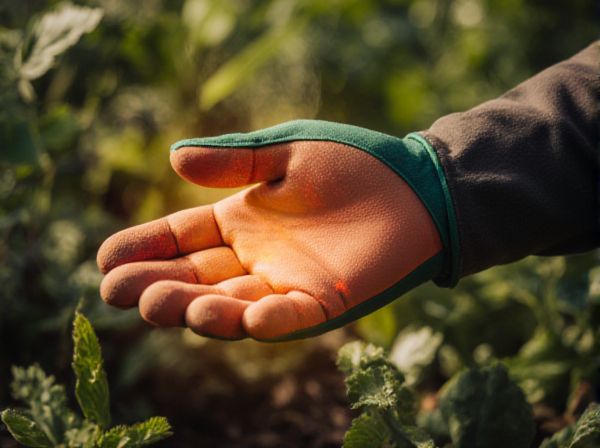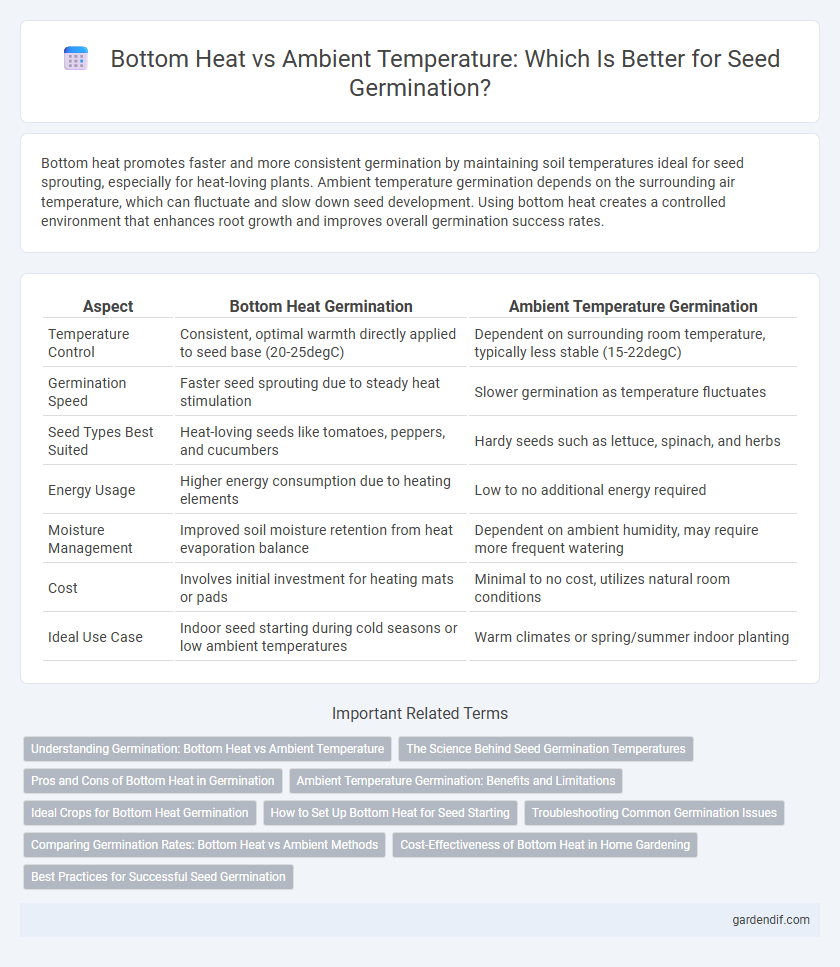
Bottom Heat vs Ambient Temperature Germination Illustration
Bottom heat promotes faster and more consistent germination by maintaining soil temperatures ideal for seed sprouting, especially for heat-loving plants. Ambient temperature germination depends on the surrounding air temperature, which can fluctuate and slow down seed development. Using bottom heat creates a controlled environment that enhances root growth and improves overall germination success rates.
Table of Comparison
| Aspect | Bottom Heat Germination | Ambient Temperature Germination |
|---|---|---|
| Temperature Control | Consistent, optimal warmth directly applied to seed base (20-25degC) | Dependent on surrounding room temperature, typically less stable (15-22degC) |
| Germination Speed | Faster seed sprouting due to steady heat stimulation | Slower germination as temperature fluctuates |
| Seed Types Best Suited | Heat-loving seeds like tomatoes, peppers, and cucumbers | Hardy seeds such as lettuce, spinach, and herbs |
| Energy Usage | Higher energy consumption due to heating elements | Low to no additional energy required |
| Moisture Management | Improved soil moisture retention from heat evaporation balance | Dependent on ambient humidity, may require more frequent watering |
| Cost | Involves initial investment for heating mats or pads | Minimal to no cost, utilizes natural room conditions |
| Ideal Use Case | Indoor seed starting during cold seasons or low ambient temperatures | Warm climates or spring/summer indoor planting |
Understanding Germination: Bottom Heat vs Ambient Temperature
Bottom heat provides a consistent, elevated soil temperature crucial for seed germination of warmth-loving plants, accelerating metabolic processes and radicle emergence. Ambient temperature germination depends on surrounding air temperature, which can fluctuate, potentially slowing seed sprouting and affecting germination rates. Optimizing soil warmth with bottom heat enhances seedling vigor, particularly for species like tomatoes and peppers that require stable thermal conditions for successful germination.
The Science Behind Seed Germination Temperatures
Seed germination is influenced by temperature, where bottom heat provides consistent warmth directly to the seedbed, accelerating enzyme activity and cellular division critical for root and shoot development. Ambient temperature germination relies on the surrounding air temperature, which can fluctuate and potentially delay metabolic processes necessary for seed sprouting. Scientific studies show that optimal seed germination occurs when soil and air temperatures align with species-specific thermal requirements, optimizing water uptake, hormone regulation, and energy metabolism.
Pros and Cons of Bottom Heat in Germination
Bottom heat in germination enhances seedling growth by providing consistent warmth directly to the soil, which accelerates metabolic processes and improves germination rates for heat-loving plants. However, excessive bottom heat can cause root damage, dehydration, and uneven moisture distribution, potentially leading to seedling stress or failure. In contrast, relying solely on ambient temperature may slow germination but reduces risks of overheating and provides a more natural thermal environment for delicate seeds.
Ambient Temperature Germination: Benefits and Limitations
Ambient temperature germination supports seed sprouting by maintaining natural environmental conditions, promoting gradual and steady growth without the risk of overheating. This method conserves energy and reduces equipment costs but may result in slower germination rates compared to bottom heat, especially in cooler climates. Seeds sensitive to temperature fluctuations might experience inconsistent germination under ambient conditions, requiring careful monitoring to ensure optimal moisture and temperature balance.
Ideal Crops for Bottom Heat Germination
Bottom heat germination is ideal for warm-season crops such as tomatoes, peppers, eggplants, and cucumbers, which require soil temperatures between 75degF and 85degF to optimize seedling growth. Providing consistent warmth directly to the seedbed enhances root development and accelerates germination rates compared to ambient temperature methods. Cool-season crops like lettuce and spinach generally perform better under ambient temperature germination conditions, as they prefer lower soil temperatures around 60degF to 70degF.
How to Set Up Bottom Heat for Seed Starting
Setting up bottom heat for seed starting involves placing a heat mat or heating cable beneath seed trays to maintain soil temperatures typically between 70-85degF (21-29degC), which accelerates germination compared to ambient air temperatures. Use a thermostat to regulate consistent warmth and prevent overheating, ensuring seeds receive optimal moisture and temperature conditions. Position the seed trays on the heat source in a draft-free environment, monitoring soil temperature rather than air temperature for best results.
Troubleshooting Common Germination Issues
Bottom heat enhances seed germination by maintaining consistent soil temperatures between 70-85degF, promoting faster root development and uniform sprouting. Ambient temperature fluctuations often cause uneven germination rates and can lead to mold growth or seed rot if temperatures drop below optimal levels. Troubleshooting involves using heating mats for bottom heat to stabilize soil warmth and monitoring humidity to prevent fungal issues during ambient temperature germination.
Comparing Germination Rates: Bottom Heat vs Ambient Methods
Bottom heat significantly accelerates germination rates by maintaining optimal soil temperatures between 70degF and 85degF, which stimulates faster seed enzyme activity compared to ambient temperature methods averaging 60degF to 75degF. Seeds under bottom heat typically sprout within 5 to 10 days, while ambient temperature germination can extend to 10 to 21 days depending on species and environmental variability. Consistent warmth from bottom heat reduces dormancy periods and improves uniformity, making it preferable for heat-loving plants like tomatoes and peppers.
Cost-Effectiveness of Bottom Heat in Home Gardening
Bottom heat enhances seed germination rates by maintaining optimal soil temperatures, which accelerates sprouting compared to relying on ambient temperature fluctuations. The energy efficiency of heat mats or heating cables offers cost-effective temperature control, reducing electricity costs while improving germination success. Home gardeners benefit from shorter germination periods and stronger seedlings, making bottom heat a practical investment for consistent plant development.
Best Practices for Successful Seed Germination
Maintaining consistent bottom heat between 70-85degF accelerates germination by activating enzymatic processes and encouraging root growth, especially for heat-loving seeds such as tomatoes and peppers. Ambient temperature germination is effective for cool-season seeds like lettuce and spinach, which typically thrive between 60-70degF, avoiding the risk of overheating sensitive seeds. Using a seedling heat mat combined with a thermostat provides controlled bottom heat, while monitoring ambient conditions ensures optimal temperature ranges, enhancing overall germination success rates.
Bottom Heat vs Ambient Temperature Germination Infographic

 gardendif.com
gardendif.com